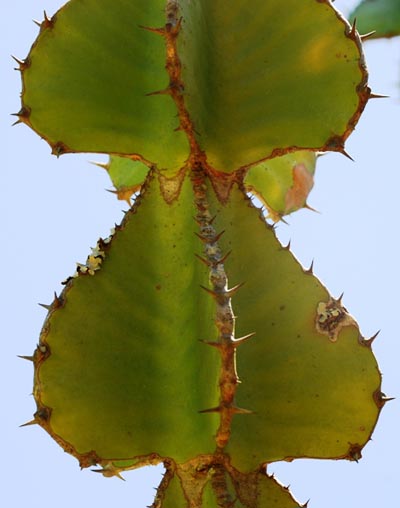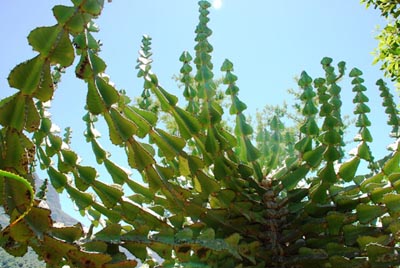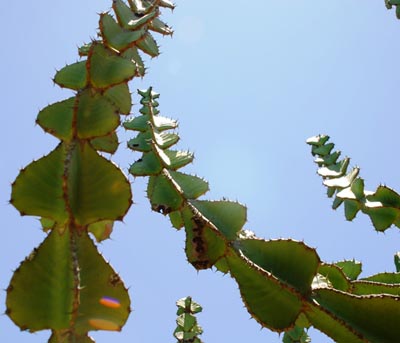|
Botanical name |
Euphorbia cooperi |
|
Other names |
Lesser candelabra tree; spurge; Transvaalse kandelaarnaboom (Afrikaans) |
|
Family |
Euphorbiaceae |
|
Dimensions |
A medium sized, spiny, succulent tree with an attractively rounded crown, achieves a height of over 7 m |
|
Description of stem |
Trunk is straight, erect and loses all lower branches in a continual process below the compact crown over time; the trunk is grey to dark grey or brown with a gnarled appearance where irregularly spaced old leaf scars (or holes) persist; the branchlets are green or yellow-green and consist of distinctly segmented sections, up to 15 cm in length , in younger plants, smaller and rounder in older plants; the heart-shaped or sometimes triangular sections form attractive upwardly curved, leafless branches; every section has four to six longitudinal lobes with pairs of spines of about 5 mm along the outer ridges that have continuous, narrow and dark spine shields running along them |
|
Description of leaves |
Very small, inconspcuous leaves that fall early are sometimes seen on the branch ridges among the spines |
|
Description of flowers |
Typical euphorbia type yellow-green cyathia are grouped in threes on the ridges of the terminal branchlet segment, appearing in spring; the central cyathium in each group is male, the other two female |
|
Desciption of seed/fruit |
Maroon, triangular, threelobed capsules adorn the top branchlet ridges in spring and summer |
|
Description of roots |
|
|
Variation |
The varieties cooperi, calidicola and ussanquensis have been described; only the first one occurs in South Africa, the others are found to the north in other African countries |
|
Propagation and cultivation |
Grown from stem cuttings |
|
Tolerances |
Drought resistant |
|
Uses |
Garden subject, e.g. for xeriscaping, although sometimes avoided by gardeners with children due to the danger of the latex; the latex is used as a fish poison that allows for the paralysed fish to be caught by hand; the fruits are eaten by birds |
|
Ecological rarity |
Common |
|
Pests and diseases |
|
|
Other |
The latex is said to be one of the most poisonous varieties among the euphorbias to both humans and animals; care should be taken when working with this plant not to ingest any of the latex, to avoid it to come into contact with the eye or even have skin contact as severe irritation and blisters may ensue; the poison, euphorbon, a protein, contained in the latex may cause human death if ingested, as the stomach wall and intestines may be inflamed and even perforated; it may also cause (temporary?) blindness; cortisone cream or Prednisone tablets have been mentioned relating to treatment; a traditional medicine antidote from E. hirta (used in Malawi) is unconfirmed as to its value (Info: www.theamateurdigest.com) |
|
Location |
Bushveld and granite outcrops |
|
Distribution (SA provinces) |
Kwazulu-Natal; Mpumalanga; Limpopo; Gauteng; North West |
|
Country |
South Africa; Zimbabwe; Swaziland; Zambia; Mozambique; Botswana; Tanzania; Malawi |


